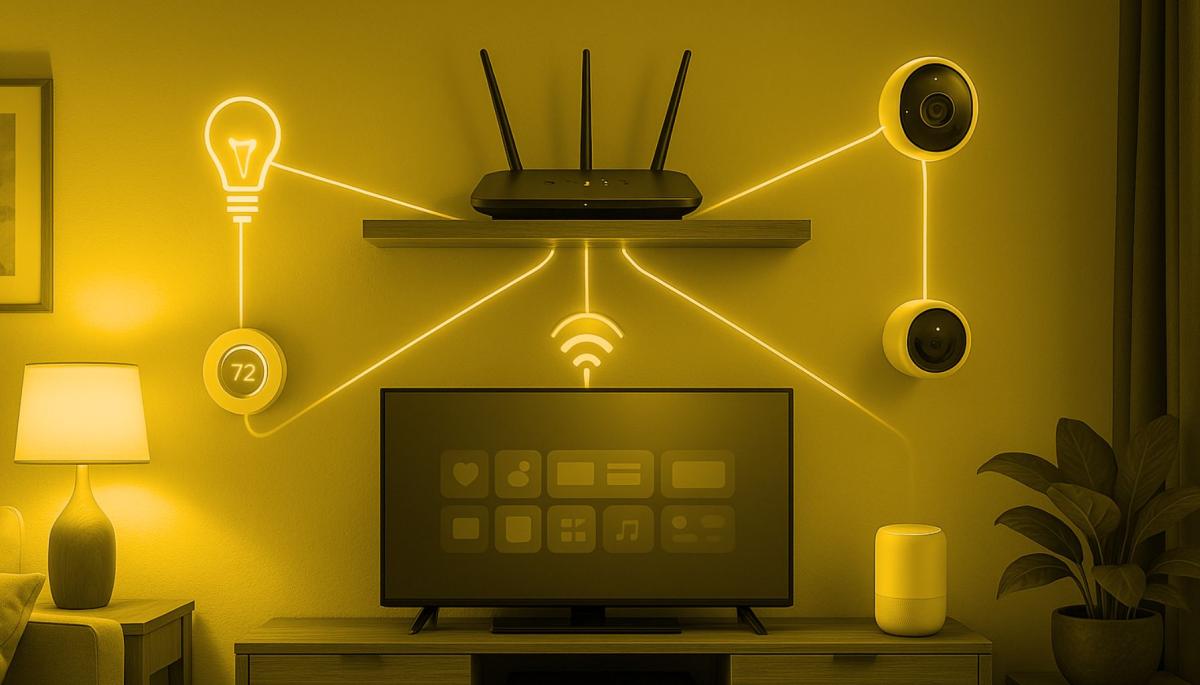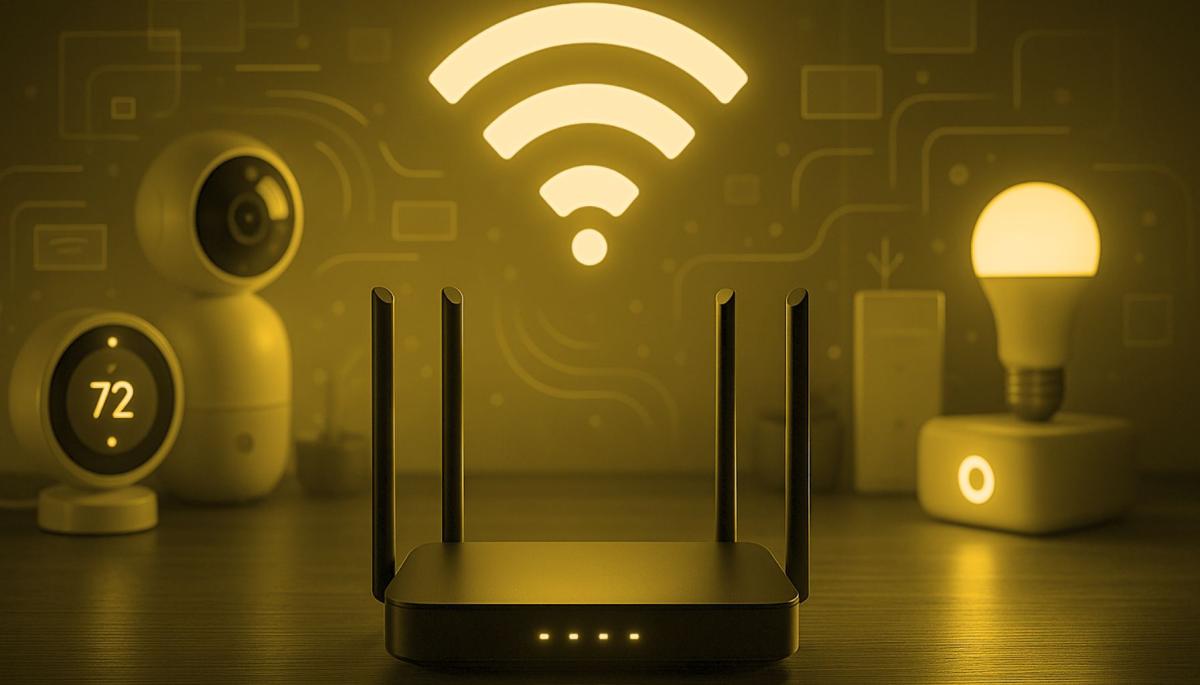Looking for a way to ensure your smart home operates without interruptions and issues? Proper setup of a home network is crucial for the smooth operation of all connected devices. Our article will guide you through selecting the right router, its strategic placement, and optimal settings for different types of households.

You're sitting at home, your internet TV is stuttering, the IP camera at the driveway isn't working, and the smart bulb is reporting an error. We all certainly agree that a smart home shouldn't function like this. One option to fix everything is the proper setup of a home network. Let's show you how to do it.
Why is network optimization important?
Today's smart home resembles a small technological ecosystem. It's not uncommon for a regular family to have more than 20 different devices connected, including smart bulbs, thermostats, security cameras, or intelligent appliances. Each of these devices constantly communicates with the internet, sending data, receiving commands, and updates.
The problem arises when all these devices start competing for the same network capacity. Without proper optimization, the network can become overloaded, response delays can occur, or even connection outages. Therefore, it's important to pay attention to home network settings and ensure that each device gets exactly the space it needs.
Basic optimization steps
If you're having trouble with the proper functioning of some devices, go through the steps below and try applying them in your home.
1. Choosing the right router
The router is the heart of your home network and its selection should be as careful as choosing any other important home appliance. While a basic router from your internet provider might suffice for regular surfing and video watching, it's usually insufficient for managing a smart home.
When selecting a router for a smart home, you should look for devices with the latest technologies. Wi-Fi 6 (also known as 802.11ax) represents the latest standard, offering up to four times higher speeds than the previous generation and is especially adept at handling a larger number of connected devices.
Another key parameter is dual or even tri-band broadcasting. This means the router transmits on multiple frequencies simultaneously—typically 2.4 GHz and 5 GHz, possibly even an additional 5 GHz band. You get multiple separate paths—a slower but more stable 2.4 GHz network for IoT devices and a faster 5 GHz for video streaming and gaming.
Another necessity is the MU-MIMO (Multi-User, Multiple-Input, Multiple-Output) technology, which allows the router to communicate with multiple devices simultaneously instead of servicing them sequentially. In practice, this means you can stream a 4K movie on the TV while security cameras continuously stream video and the smart refrigerator downloads updates.
A great feature is the ability to create a separate network for IoT devices. This setup isn't just a matter of convenience but primarily of security. Smart devices are often targeted by hackers, and if they're on a separate network, a potential attacker won't get access to your personal and sensitive data. The router should also not lack LAN ports for more reliable connections.

2. Strategic router placement
The placement of the router dramatically affects the quality of Wi-Fi throughout the house. The ideal position is in the central part of the home, preferably at about 1.5 meters above the ground. Avoid placing the router in the basement, behind furniture, or in closed cabinets. Each obstacle weakens the signal.
Metal objects, in particular, can completely block the signal. This applies to mirrors, aquariums, or metal radiators as well. A regular wall only weakens the signal, but a metal construction can stop it entirely.
In modern homes, there are also many electronic enemies of Wi-Fi signals. A microwave oven, cordless phone, or even LED lighting can cause interference because they often operate on the same frequency as Wi-Fi. Therefore, it is important to place the router at least two meters away from these devices.
For larger houses or apartments with complex layouts, the only functional solution is a Wi-Fi mesh system. It works as a network of interconnected transmitters, creating uniform coverage without dead zones.
3. Security settings
Every connected device represents a potential entry point for cyber attackers. The first line of defense is a strong password for your Wi-Fi network. Forget simple combinations like "12345678." An ideal password should have at least 12 characters and contain a mix of uppercase and lowercase letters, numbers, and special characters.
Modern routers offer advanced WPA3 encryption, which is the current gold standard in wireless network security. If your router offers this option, definitely activate it. WPA3 provides significantly better protection against brute force attacks and secures communication between devices in the network.
Equally important are regular firmware updates for the router. Manufacturers constantly discover and fix security vulnerabilities, but these fixes only reach you through updates.
A good option is also to create a separate network for IoT devices. Smart bulbs, thermostats, or home appliances often do not have as high a security level as computers or phones. Isolating them on a separate network ensures that even if an attacker gets through some of these devices, they won't gain access to your personal data on computers or phones.
4. Network traffic optimization
Your home network is like a highway, where different vehicles (devices) need different priorities for passage. This is where QoS (Quality of Service) comes into play—an intelligent traffic management system in your network. It allows you to ensure that a video call from a home office or a stream from a security camera takes precedence over downloading updates for a smart refrigerator.
DHCP reservations then ensure that key devices always get the same IP address, which is important for the stability of their connection. Don't forget to regularly check the network load. Modern routers offer clear statistics, making it easy to identify bandwidth hogs.
Sometimes the solution can be limiting the number of concurrently connected devices—not all devices need to be online 24/7. For example, smart bulbs in the bedroom can be disconnected at night or set to automatically turn off the Wi-Fi module in devices that are not actively used.
Recommendations for different types of households
Network optimization can also be addressed according to the size of the household. Each has its specifics and needs. Below, we have divided them into small apartments, family houses, and large smart homes.
Small apartment
For a small apartment up to 60–70 m², it's important to find the right balance between performance and simplicity. A single quality router with Wi-Fi 6 support, strategically placed in the central part of the apartment, usually manages to cover the entire area with a stable signal.
Even in a small apartment, it's important to think about basic security measures such as a strong password, WPA3 encryption, and regular firmware updates. This setup will suffice for 5 to 15 connected devices.

Family house
For a family house with an area of 100-200 m² across multiple floors, a simple router usually proves inadequate. Here, a mesh Wi-Fi system comes into play—a network of interconnected access points creating seamless coverage over the entire house.
Such a system can effectively cover problematic areas like the basement or garden. Typically, you can cover 15 to 30 devices this way. For safe operation, it's good to allocate a separate network for IoT devices and set up QoS.
Large smart home
In large smart homes with an area of more than 200 m² and dozens of connected devices, a professional network infrastructure is necessary. The foundation includes network equipment comprising a powerful main router, several strategically placed access points, and managed switches for efficient traffic management.
For maximum reliability, some devices need to be connected via Ethernet cables. An important element of these installations is also redundant systems—backup internet from a second provider, UPS for critical network devices, and backup systems for important data.
In such extensive installations, it's not uncommon to have 50 to 100 connected devices, from smart garden irrigation to comprehensive heating systems to advanced multimedia systems. The management of such a network often requires professional monitoring and regular maintenance, similar to any other complex technical system in the house.
Proper network optimization is crucial for the functioning of a smart home. Investment in quality equipment and time spent on configuration will pay off in the form of reliable and secure operation of all connected devices.
Remember, however, that network optimization is not a one-time matter but a continuous process. Regularly check and update settings according to the changing needs of your household.
What will 6G internet bring – lightning-fast connection, smart cities, and artificial intelligence in the network

Mobile networks of the sixth generation will push the boundaries of communication and data transmission. 6G internet will offer speeds in the order of terabits, minimal delay, and integration with artificial intelligence. In the article, we explain how this technology works, how it differs from 5G, what frequencies it uses, and why it is essential for smart cities and modern industry.
Wireless charging: What are its benefits, limitations, and where is it heading?

Wireless charging has evolved from a luxury feature to a standard part of most modern phones. Simply place your mobile on the pad, and energy begins to flow without searching for a cable and connector. We explain how wireless charging works, what it entails, and why Qi and Qi2 technologies have become the new standard of convenience.
What is Wi-Fi 7? What changes does it bring and when does it make sense to switch

Today's home Wi-Fi network is under increasing pressure. It has to handle video calls, online gaming, and dozens of smart devices. The new Wi-Fi 7 standard offers a solution that takes wireless connectivity to the next level. We'll explain what this standard means in practice and why it might be crucial for the future of home and business networks.
What is DNS? Everything you need to know about its functionality and setup

When you type a website address into the browser, the correct page loads in an instant. This is managed by the DNS system, without which the internet as we know it would not exist at all. In this article, you will learn what DNS is, how it works, what types of records it contains, and why it is important for both speed and security of the connection.
How does fiber optic internet work and what do you need for its installation?

Fast and stable connection is a basic necessity in every household today. The solution is fiber optic internet, which works differently than regular cables and offers greater reliability to users. We'll explain how this technology works in practice, what it entails to run a fiber optic cable to your home, and what equipment you’ll need to keep everything running smoothly.
Cloud gaming – the end of consoles in sight?

Cloud gaming allows you to play games from anywhere without the need for expensive hardware. In this article, you'll learn how game streaming works, what advantages and limitations it brings, and which services are leading the way today. And most importantly: can it really threaten traditional consoles?